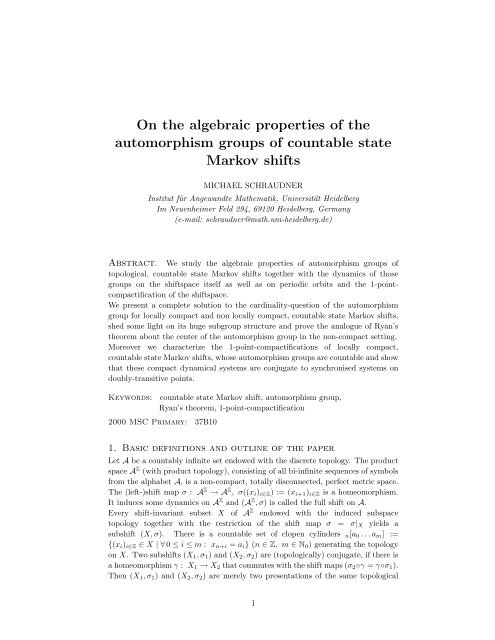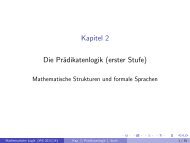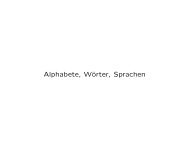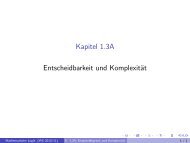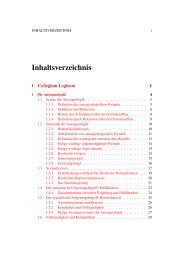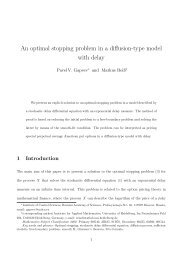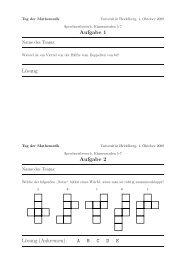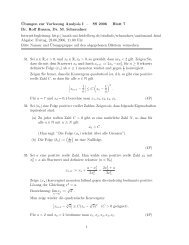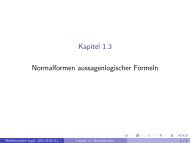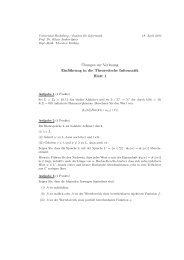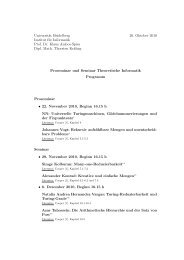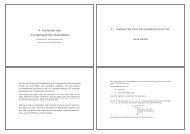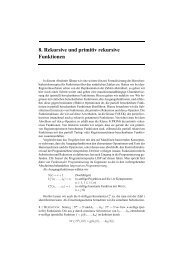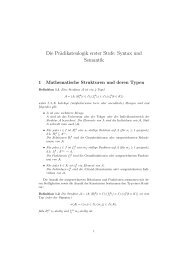On the algebraic properties of the automorphism groups of ... - CMM
On the algebraic properties of the automorphism groups of ... - CMM
On the algebraic properties of the automorphism groups of ... - CMM
You also want an ePaper? Increase the reach of your titles
YUMPU automatically turns print PDFs into web optimized ePapers that Google loves.
<strong>On</strong> <strong>the</strong> <strong>algebraic</strong> <strong>properties</strong> <strong>of</strong> <strong>the</strong><strong>automorphism</strong> <strong>groups</strong> <strong>of</strong> countable stateMarkov shiftsMICHAEL SCHRAUDNERInstitut für Angewandte Ma<strong>the</strong>matik, Universität HeidelbergIm Neuenheimer Feld 294, 69120 Heidelberg, Germany(e-mail: schraudner@math.uni-heidelberg.de)Abstract. We study <strong>the</strong> <strong>algebraic</strong> <strong>properties</strong> <strong>of</strong> <strong>automorphism</strong> <strong>groups</strong> <strong>of</strong>topological, countable state Markov shifts toge<strong>the</strong>r with <strong>the</strong> dynamics <strong>of</strong> those<strong>groups</strong> on <strong>the</strong> shiftspace itself as well as on periodic orbits and <strong>the</strong> 1-pointcompactification<strong>of</strong> <strong>the</strong> shiftspace.We present a complete solution to <strong>the</strong> cardinality-question <strong>of</strong> <strong>the</strong> <strong>automorphism</strong>group for locally compact and non locally compact, countable state Markov shifts,shed some light on its huge subgroup structure and prove <strong>the</strong> analogue <strong>of</strong> Ryan’s<strong>the</strong>orem about <strong>the</strong> center <strong>of</strong> <strong>the</strong> <strong>automorphism</strong> group in <strong>the</strong> non-compact setting.Moreover we characterize <strong>the</strong> 1-point-compactifications <strong>of</strong> locally compact,countable state Markov shifts, whose <strong>automorphism</strong> <strong>groups</strong> are countable and showthat <strong>the</strong>se compact dynamical systems are conjugate to synchronised systems ondoubly-transitive points.Keywords:countable state Markov shift, <strong>automorphism</strong> group,Ryan’s <strong>the</strong>orem, 1-point-compactification2000 MSC Primary: 37B101. Basic definitions and outline <strong>of</strong> <strong>the</strong> paperLet A be a countably infinite set endowed with <strong>the</strong> discrete topology. The productspace A Z (with product topology), consisting <strong>of</strong> all bi-infinite sequences <strong>of</strong> symbolsfrom <strong>the</strong> alphabet A, is a non-compact, totally disconnected, perfect metric space.The (left-)shift map σ : A Z → A Z , σ((x i ) i∈Z ) := (x i+1 ) i∈Z is a homeomorphism.It induces some dynamics on A Z and (A Z , σ) is called <strong>the</strong> full shift on A.Every shift-invariant subset X <strong>of</strong> A Z endowed with <strong>the</strong> induced subspacetopology toge<strong>the</strong>r with <strong>the</strong> restriction <strong>of</strong> <strong>the</strong> shift map σ = σ| X yields asubshift (X, σ). There is a countable set <strong>of</strong> clopen cylinders n [a 0 . . . a m ] :={(x i ) i∈Z ∈ X | ∀ 0 ≤ i ≤ m : x n+i = a i } (n ∈ Z, m ∈ N 0 ) generating <strong>the</strong> topologyon X. Two subshifts (X 1 , σ 1 ) and (X 2 , σ 2 ) are (topologically) conjugate, if <strong>the</strong>re isa homeomorphism γ : X 1 → X 2 that commutes with <strong>the</strong> shift maps (σ 2 ◦γ = γ◦σ 1 ).Then (X 1 , σ 1 ) and (X 2 , σ 2 ) are merely two presentations <strong>of</strong> <strong>the</strong> same topological1
2 M. Schraudnerdynamical object and we denote by Pres(X) <strong>the</strong> set <strong>of</strong> all presentations <strong>of</strong> <strong>the</strong>subshift (X, σ), i.e. <strong>the</strong> set <strong>of</strong> all subshifts conjugate to (X, σ).Let G = (V, E) be a directed graph with vertex set V , edge set E toge<strong>the</strong>rwith <strong>the</strong> maps i, t : E → V , where i(e) gives <strong>the</strong> initial and t(e) <strong>the</strong> terminalvertex <strong>of</strong> an edge e ∈ E. A subshift (X, σ) is called countable state Markovshift,{if its set <strong>of</strong> presentations contains an edge shift (X G , σ), with X G :=(xi ) i∈Z ∈ E Z | ∀ i ∈ Z : t(x i ) = i(x i+1 ) } <strong>the</strong> set <strong>of</strong> bi-infinite walks along <strong>the</strong> edges<strong>of</strong> a countably infinite directed graph G (|E| = ℵ 0 ) and σ acting on X G . If not statedexplicitly all graphs are directed, having a countably infinite set <strong>of</strong> edges. W.l.o.g.<strong>the</strong> graphs considered are assumed to be essential, i.e. <strong>the</strong> in- and out-degree atevery vertex is strictly positive. (X G , σ) is <strong>the</strong>n called a graph presentation <strong>of</strong>(X, σ) and Graph(X) denotes <strong>the</strong> set <strong>of</strong> all graph presentations <strong>of</strong> (X, σ).For every point x ∈ X in a subshift (X, σ) and m ≤ n ∈ Z let x [m,n] , x [m,∞) andx (−∞,n] respectively denote <strong>the</strong> block x m x m+1 . . . x n−1 x n , a right- or a left-infiniteray <strong>of</strong> x. In an edge shift x [m,n] corresponds to a finite path <strong>of</strong> length n − m + 1,whereas x [m,∞) and x (−∞,n] are equivalent to right- and left-infinite walks.We define <strong>the</strong> language B(X) <strong>of</strong> a subshift (X, σ) as <strong>the</strong> disjoint union <strong>of</strong> all sets<strong>of</strong> blocks B m (X) := { ∣ }x [0,m−1] x ∈ X ⊆ A m (m ∈ N). |w| denotes <strong>the</strong> length andw n (n ∈ N 0 ˙∪ {∞}) <strong>the</strong> n-times concatenation <strong>of</strong> a block w ∈ B(X).A subshift (X, σ) is called locally compact, if X is locally compact. For countablestate Markov shifts this implies <strong>the</strong> compactness <strong>of</strong> every cylinder set. An edgeshift (X G , σ) is locally compact, iff every vertex in G has finite in- and out-degree(G is locally finite).A subshift (X, σ) is called (topologically) transitive, if X is irreducible, i.e. for everypair u, w ∈ B(X) <strong>of</strong> blocks <strong>the</strong>re is a block v ∈ B(X), such that u v w ∈ B(X). Anedge shift (X G , σ) is transitive, iff G is strongly connected.Let Orb(X) := {Orb(x) | x ∈ X} <strong>the</strong> set <strong>of</strong> σ-orbits Orb(x) := {σ n (x) | n ∈ Z} ⊆X. Using <strong>the</strong> backward-orbit Orb − (x) := {σ −n (x) | n ∈ N 0 } and <strong>the</strong> forwardorbitOrb + (x) := {σ n (x) | n ∈ N 0 } we define <strong>the</strong> set <strong>of</strong> doubly-transitive pointsDT(X) := { x ∈ X | Orb − (x), Orb + (x) both are dense in X } . For transitivesubshifts this set is non-empty and dense. Let x ∈ DT(X) <strong>the</strong>n every blockw ∈ B(X) is contained infinitely <strong>of</strong>ten in x (−∞,0] and x [0,∞) .Finally we define <strong>the</strong> set <strong>of</strong> periodic points Per(X) := ⋃ n∈N Per n(X) =⋃˙n∈N Per0 n(X) under <strong>the</strong> action <strong>of</strong> σ, where Per n (X) denotes <strong>the</strong> set <strong>of</strong> points <strong>of</strong>period n and Per 0 n(X) <strong>the</strong> set <strong>of</strong> points <strong>of</strong> least period n. For transitive, countablestate subshifts Per(X) is a countable dense subset in X.For fur<strong>the</strong>r notions and background information on subshifts we refer to <strong>the</strong>monographs on symbolic dynamics by D. Lind and B. Marcus [LM] and by B.Kitchens [Kit].Now we recall <strong>the</strong> fundamental definition <strong>of</strong> this paper: Let (X, σ) be some subshift.A map ϕ : X → X is called an <strong>automorphism</strong> (<strong>of</strong> σ), if ϕ is a self-conjugacy,i.e. a shiftcommuting homeomorphism from X onto itself. Obviously <strong>the</strong> set <strong>of</strong><strong>automorphism</strong>s forms a group Aut(σ) under composition. It is an invariant <strong>of</strong>topological conjugacy reflecting <strong>the</strong> inner structure and symmetries <strong>of</strong> <strong>the</strong> subshift.For subshifts <strong>of</strong> finite type (SFTs) <strong>the</strong>re is an extensive and pr<strong>of</strong>ound <strong>the</strong>ory dealingwith <strong>automorphism</strong>s (see e.g. [BK1], [BK2], [BLR], [FieU1], [FieU2], [Hed],
Automorphism <strong>groups</strong> <strong>of</strong> countable state Markov shifts 3[KR1], [KR2], [KRW1] and [KRW2]) and leading to very deep and strong resultsconcerning <strong>the</strong> conjugacy problem, <strong>the</strong> FOG-conjecture or <strong>the</strong> LIFT-hypo<strong>the</strong>sis.The <strong>automorphism</strong> group <strong>of</strong> any nontrivial SFT is a countably infinite, residuallyfinite group (<strong>the</strong>refore it cannot contain any infinite simple or any nontrivialdivisible subgroup) with center isomorphic to Z. It is discrete with respect to<strong>the</strong> compact-open topology, does not contain any finitely generated sub<strong>groups</strong> withunsolvable word problem, but admits embeddings <strong>of</strong> a great variety <strong>of</strong> o<strong>the</strong>r <strong>groups</strong>(see section 4).The <strong>automorphism</strong> <strong>groups</strong> <strong>of</strong> coded systems have been studied in [FF2] with quitedifferent results (<strong>the</strong>y are much smaller and can be stipulated explicitely; <strong>the</strong>ircenter can be isomorphic to a wide range <strong>of</strong> abstract <strong>groups</strong>), whereas to ourknowledge <strong>the</strong>re are yet no published results on <strong>automorphism</strong>s <strong>of</strong> countable stateMarkov shifts.Trying to fill part <strong>of</strong> this gap, <strong>the</strong> present paper contains results from <strong>the</strong> authorsPh.D. <strong>the</strong>sis [Sch]. In section 2 we determine <strong>the</strong> cardinality <strong>of</strong> Aut(σ) for locallycompact and non locally compact, countable state Markov shifts and give severalequivalent criteria for Aut(σ) being countable. In section 3 we study <strong>the</strong> 1-pointcompactifications<strong>of</strong> locally compact, countable state Markov shifts with Aut(σ)countable. Those compact dynamical systems need no longer be expansive, thatis in general <strong>the</strong>y aren’t conjugate to any subshift. Instead <strong>the</strong> property Aut(σ)countable is equivalent to expansiveness being restricted to doubly-transitive points.Fur<strong>the</strong>rmore this implies <strong>the</strong> existence <strong>of</strong> an almost invertible 1-block-factor-mapfrom <strong>the</strong> compactification onto some synchronised system. Section 4 containssome results on <strong>the</strong> subgroup structure <strong>of</strong> Aut(σ). Like in <strong>the</strong> SFT-case we canrealize lots <strong>of</strong> abstract <strong>groups</strong> via marker constructions. The gradual fading <strong>of</strong>compactness ((FMDP), locally compact, non locally compact) shows up in adecrease <strong>of</strong> <strong>algebraic</strong> restrictions and an increase <strong>of</strong> possible sub<strong>groups</strong>. This makesit very difficult to describe Aut(σ) as an abstract group. Stimulated by <strong>the</strong> wellknownresult <strong>of</strong> J. Ryan [Rya1],[Rya2] on <strong>the</strong> center <strong>of</strong> Aut(σ) for SFTs, we areable to reprove this <strong>the</strong>orem for non-compact Markov shifts in section 5. ThereforeAut(σ) is again highly non-abelian (in contrast to <strong>the</strong> coded-systems-case) and <strong>the</strong>periodic-orbit representation is faithful on Aut(σ)/ 〈σ〉 .2. The cardinality <strong>of</strong> Aut(σ)Let S N be <strong>the</strong> set <strong>of</strong> all bijective mappings from N (or generally any countablyinfinite set) onto itself. We call S N <strong>the</strong> full permutation group (on a countable set).Its cardinality is 2 ℵ0 . By S N,f we denote <strong>the</strong> subgroup <strong>of</strong> finite permutations, i.e.<strong>the</strong> set <strong>of</strong> all bijective mappings from N onto itself that fix all but finitely manyelements. The cardinality <strong>of</strong> S N,f is ℵ 0 .Proposition 2.1. The <strong>automorphism</strong> group <strong>of</strong> every transitive, countable stateMarkov shift is isomorphic to a subgroup <strong>of</strong> S N and <strong>the</strong>refore has cardinality atmost 2 ℵ0 .Pro<strong>of</strong>: Since <strong>the</strong> Markov shift (X, σ) is transitive, <strong>the</strong> countable set <strong>of</strong> periodicpoints Per(X) is dense in X and every <strong>automorphism</strong> ϕ ∈ Aut(σ) is uniquelydetermined by its action on Per(X). Therefore Aut(σ) ≤ S Per(X)∼ = SN . ✷
4 M. SchraudnerNow we can state <strong>the</strong> cardinality-result for non locally compact Markov shifts:Theorem 2.2. Every transitive, non locally compact, countable state Markov shifthas an <strong>automorphism</strong> group <strong>of</strong> cardinality 2 ℵ0 .Pro<strong>of</strong>: Let G = (V, E) be a graph presentation for <strong>the</strong> non locally compactMarkov shift (X, σ). W.l.o.g. we may assume that <strong>the</strong>re is a vertex v ∈ V withinfinite out-degree (<strong>the</strong> symmetric situation <strong>of</strong> a vertex with infinite in-degree canbe treated via time-reversal, i.e. carrying out <strong>the</strong> following construction for <strong>the</strong>transposed graph).Let {e j | j ∈ N} ⊆ E be <strong>the</strong> set <strong>of</strong> edges starting at v. For every j /∈ 3N choosea shortest path p j from t(e j ) back to v (G is strongly connected); p j is empty, ift(e j ) = v. This gives an infinite set <strong>of</strong> distinct loops l j := e j p j at <strong>the</strong> vertex v.Use <strong>the</strong> edges e j (j ∈ 3N) as markers to define maps φ i : X → X (i ∈ N) thatinterchange <strong>the</strong> blocks l 3i−2 l 3i−1 e 3i and l 3i−1 l 3i−2 e 3i in every point x ∈ X andtake no fur<strong>the</strong>r action.By construction no path p j (j /∈ 3N) can contain an edge e i (i ∈ N). This guaranteesthat no loop l j (j /∈ 3N) contains any edge e 3i and no two loops can overlappartially. Therefore every φ i is well-defined. φ i is an involutorial sliding-block-codewith coding length 2 |l 3i−2 l 3i−1 | + 1. So we have constructed a countable set <strong>of</strong>distinct <strong>automorphism</strong>s {φ i | i ∈ N} ⊆ Aut(σ).Next consider infinite products <strong>of</strong> <strong>the</strong> maps φ i and show that for every 0/1-sequence(a k ) k∈N ∈ {0, 1} N <strong>the</strong>re is a well-defined <strong>automorphism</strong> ϕ (ak ) := ∏ i∈N φ i ai :Distinct <strong>automorphism</strong>s φ i act on disjoint blocks ending with <strong>the</strong> symbol e 3i .Fur<strong>the</strong>rmore <strong>the</strong> {e 3i | i ∈ N}-skeleton, i.e. <strong>the</strong> coordinates at which a symbole 3i appears remain invariant under any composition <strong>of</strong> φ i s. The φ i commutewith each o<strong>the</strong>r and <strong>the</strong> infinite product ϕ (ak ) is defined independently <strong>of</strong> <strong>the</strong>order <strong>of</strong> composition. We get (ϕ (ak )) 2 = ( ∏ i∈N φ i ai ) 2 = ∏ i∈N φ i 2ai = Id X andϕ (ak )(X) ⊆ X, so ϕ (ak ) is a well-defined order 2 bijection from X onto X andobviously ϕ (ak ) commutes with <strong>the</strong> shift map.To show that ϕ (ak ) (and ϕ (ak ) −1 = ϕ (ak )) is continuous, it suffices to show that <strong>the</strong>zero-coordinate <strong>of</strong> <strong>the</strong> image is prescribed by a finite block <strong>of</strong> <strong>the</strong> preimage:Fix x ∈ X. The symbol x 0 is unchanged unless it is part <strong>of</strong> some block l 3i−2 l 3i−1 e 3ior l 3i−1 l 3i−2 e 3i . Let n be <strong>the</strong> length <strong>of</strong> a shortest path from t(x 0 ) to <strong>the</strong> vertexv. Whenever x n+1 /∈ {e i | i ∈ N} we have ( ϕ (ak )(x) ) = x 0 0. In this case <strong>the</strong> blockx [0,n+1] decides about <strong>the</strong> zero-coordinate <strong>of</strong> <strong>the</strong> image. If x n+1 = e j for some j ∈ N<strong>the</strong> only <strong>automorphism</strong> in <strong>the</strong> product that can act on <strong>the</strong> zero-coordinate is φ i withi := ⌈ (j3⌉. We have ϕ(ak )(x) ) = ( aφ i0 i (x) ) . Since φ 0 i is sliding-block, ( ϕ (ak )(x) ) 0is determined by <strong>the</strong> knowledge <strong>of</strong> a finite block <strong>of</strong> x. As ϕ (ak ) commutes with σ,this proves continuity.Two distinct 0/1-sequences (a k ) k∈N , (b k ) k∈N ∈ {0, 1} N define distinct <strong>automorphism</strong>sϕ (ak ), ϕ (bk ). For i ∈ N such that a i ≠ b i , <strong>the</strong> point x :=(l 3i−2 l 3i−1 e 3i p 3i ) ∞ ∈ X (p 3i a shortest path from t(e 3i ) back to v) has differentimages under ϕ (ak ) and ϕ (bk ). Therefore we have constructed a subgroup { ϕ (ak∣)(a k ) k∈N ∈ {0, 1} N} ≤ Aut(σ) <strong>of</strong> cardinality 2 ℵ0 . ✷
Automorphism <strong>groups</strong> <strong>of</strong> countable state Markov shifts 5We remark that though all φ i in <strong>the</strong> pro<strong>of</strong> <strong>of</strong> <strong>the</strong>orem 2.2 are sliding-block-codes,i.e. uniformly continuous maps, <strong>the</strong> infinite products ϕ (ak ) needn’t have boundedcoding length and are in general merely continuous.To answer <strong>the</strong> cardinality-question for locally compact, countable state Markovshifts we need <strong>the</strong> notion <strong>of</strong> a doublepath in a directed graph:A pair <strong>of</strong> two distinct paths p, q <strong>of</strong> equal length (|p| = |q|), connecting <strong>the</strong> sameinitial with <strong>the</strong> same terminal vertex is called a doublepath and is denoted [p; q].By definition we have [p; q] = [q; p] and in slight abuse <strong>of</strong> notation i(p) = i(q) andt(p) = t(q).Two doublepaths [p 1 ; q 1 ] and [p 2 ; q 2 ] are edge-disjoint, if <strong>the</strong> union <strong>of</strong> all edges inp 1 and q 1 is disjoint from all edges in p 2 union q 2 .A strongly connected, directed graph has <strong>the</strong> property (FMDP), if it contains atmost Finitely Many pairwise edge-disjoint DoublePaths.Theorem 2.3. Let (X, σ) be a transitive, locally compact, countable state Markovshift. Aut(σ) has cardinality ℵ 0 , iff any (every) graph presentation <strong>of</strong> (X, σ) has(FMDP). O<strong>the</strong>rwise Aut(σ) has cardinality 2 ℵ0 .The pro<strong>of</strong> <strong>of</strong> <strong>the</strong>orem 2.3 is given in three steps:Lemma 2.4. Let (X G , σ) be any graph presentation <strong>of</strong> a transitive, locally compact,countable state Markov shift on some directed graph G containing infinitely many,pairwise edge-disjoint doublepaths. Then Aut(σ) has cardinality 2 ℵ0 .Pro<strong>of</strong>: Since X G is irreducible and locally compact, G has to be stronglyconnected and locally finite. Let P := {[p i ; q i ] | i ∈ N} be an infinite set <strong>of</strong> pairwiseedge-disjoint doublepaths in G. For every [p i ; q i ] choose a marker edge e i startingat t(p i ) = t(q i ) that is not contained in this doublepath. This is possible, since bothpaths p i , q i may be extended by <strong>the</strong> same finite set <strong>of</strong> edges already contained in[p i ; q i ] until <strong>the</strong>y end at a vertex, at which an edge not contained in [p i ; q i ] starts.Take such an edge as marker and use <strong>the</strong> enlarged doublepath in place <strong>of</strong> [p i ; q i ].Inductively we construct an infinite subset Q ⊆ P <strong>of</strong> doublepaths (with adjointmarkers) such that all marker edges are distinct and no one does occur in any <strong>of</strong><strong>the</strong> doublepaths in Q: Let Q := ∅. Choose [p; q] ∈ P ; define Q := Q ˙∪ {[p; q]}. Dueto <strong>the</strong> local finiteness <strong>of</strong> G <strong>the</strong>re are at most finitely many elements in <strong>the</strong> set Pwhose markers are part <strong>of</strong> [p; q]. After removing this finite subset, <strong>the</strong> element [p; q]itself as well as <strong>the</strong> doublepath (if <strong>the</strong>re is one) containing <strong>the</strong> marker <strong>of</strong> [p; q] fromP , we are left with a still infinite set. Choosing one <strong>of</strong> <strong>the</strong> remaining doublepathswe iterate this procedure to build up an infinite subset Q as desired. For simplicity<strong>of</strong> notation renumber <strong>the</strong> elements in Q to get Q = {[p i ; q i ] | i ∈ N}.For every 0/1-sequence (a k ) k∈N ∈ {0, 1} N define a map ϕ (ak ) : X G → X G thatinterchanges every block p i e i and q i e i in a point in X G , iff a i = 1. Caused byedge-disjointness <strong>of</strong> <strong>the</strong> doublepaths [p i ; q i ] ∈ Q and <strong>the</strong> use <strong>of</strong> <strong>the</strong> distinct markerse i , being edge-disjoint from all elements in Q, no partial overlaps are possibleand ϕ (ak ) is well-defined. ϕ (ak ) commutes with σ by construction. Fur<strong>the</strong>rmoreϕ (ak )(X G ) ⊆ X G and ϕ (ak ) 2 = Id XG , that is ϕ (ak ) = ϕ (ak ) −1 is bijective.
6 M. SchraudnerContinuity <strong>of</strong> ϕ (ak ) is shown as in <strong>the</strong> pro<strong>of</strong> <strong>of</strong> <strong>the</strong>orem 2.2. The zero-coordinate <strong>of</strong>x ∈ X G is unchanged unless x 0 is part <strong>of</strong> a by definition <strong>of</strong> Q uniquely determineddoublepath [p j ; q j ] ∈ Q. Looking at <strong>the</strong> finite block x [1−|pj|,|p j|] one can decideabout ( ϕ (ak )(x) ) 0 : Suppose x [m,m+|p j|] = p j e j for some 1 − |p j | ≤ m ≤ 0 anda j = 1, <strong>the</strong>n <strong>the</strong> zero-coordinate <strong>of</strong> <strong>the</strong> image has to be <strong>the</strong> (1−m)-th symbol <strong>of</strong> <strong>the</strong>block q j . Analogously for x [m,m+|pj|] = q j e j . In all o<strong>the</strong>r cases ( ϕ (ak )(x) ) 0 = x 0.Therefore ϕ (ak ) is a shiftcommuting homeomorphism.Obviously distinct sequences (a k ) k∈N , (b k ) k∈N ∈ {0, 1} N give rise to distinct mapsϕ (ak ) ≠ ϕ (bk ), because for i ∈ N such that a i ≠ b i <strong>the</strong> images ϕ (ak )(x) and ϕ (bk )(x)<strong>of</strong> a point x ∈ X G with x [0,|pi|] = p i e i differ. This shows <strong>the</strong> existence <strong>of</strong> a subgroup∣ (ak ) k∈N ∈ {0, 1} N} ≤ Aut(σ) <strong>of</strong> cardinality 2 ℵ0 .✷{ϕ(ak )For <strong>the</strong> next lemma we need <strong>the</strong> notion <strong>of</strong> <strong>the</strong> F -skeleton <strong>of</strong> a bi-infinite sequence:Let F ⊆ A be a subset <strong>of</strong> some alphabet{ A. The F -skeleton <strong>of</strong> a point x ∈ A Z isxi if x i ∈ F<strong>the</strong> partial map κ x : Z → F , κ x (i) :=(↑ signals an undefined↑ o<strong>the</strong>rwisevalue <strong>of</strong> κ x ).Lemma 2.5. A locally finite, strongly connected graph G = (V, E) has property(FMDP), iff <strong>the</strong>re is a finite set F ⊆ E <strong>of</strong> edges, such that every doubly-transitivewalk along <strong>the</strong> edges <strong>of</strong> G is uniquely determined by its F -skeleton.Pro<strong>of</strong>: W.l.o.g. we may assume |E| = ℵ 0 , since o<strong>the</strong>rwise F := E is a goodchoice to prove <strong>the</strong> statement.”⇐=”: Suppose G does not have (FMDP), <strong>the</strong>n for every finite set F E <strong>the</strong>reis a doublepath [p; q] that does not contain an edge from F (in fact <strong>the</strong>re areinfinitely many). The path p occurs infinitely <strong>of</strong>ten in every doubly-transitive walk.Exchanging one such block p by <strong>the</strong> block q gives ano<strong>the</strong>r doubly-transitive walk,that obviously has <strong>the</strong> same F -skeleton.”=⇒”: Assume that P := {[p n ; q n ] | 1 ≤ n ≤ N} is a maximal, finite set <strong>of</strong> pairwiseedge-disjoint doublepaths in G (having (FMDP)). Let F E be <strong>the</strong> union <strong>of</strong>all edges that show up in elements <strong>of</strong> P . F is a finite set. Suppose <strong>the</strong>re aretwo doubly-transitive walks x, y ∈ DT(X G ) with <strong>the</strong> same F -skeleton. There arecoordinates i ≤ j ∈ Z such that x i−1 = y i−1 , x j+1 = y j+1 ∈ F , x k , y k /∈ F for alli ≤ k ≤ j and x [i,j] ≠ y [i,j] . This implies <strong>the</strong> existence <strong>of</strong> a doublepath [x [i,j] ; y [i,j] ]<strong>of</strong> length j − i + 1 connecting t(x i−1 ) = t(y i−1 ) with i(x j+1 ) = i(y j+1 ), which isedge-disjoint to all elements in P . This contradicts <strong>the</strong> maximality <strong>of</strong> P . ✷This equivalent reformulation <strong>of</strong> <strong>the</strong> property (FMDP) is enough to finish <strong>the</strong>pro<strong>of</strong> <strong>of</strong> <strong>the</strong>orem 2.3:Lemma 2.6. Let <strong>the</strong> transitive, locally compact, countable state Markov shift (X, σ)be presented on some directed graph G = (V, E). Suppose <strong>the</strong>re is a finite set F E<strong>of</strong> edges such that every doubly-transitive point in X is uniquely determined by itsF -skeleton, <strong>the</strong>n Aut(σ) is countably infinite.Pro<strong>of</strong>: Again G has to be a stongly connected, locally finite graph with |E| = ℵ 0 .As all powers <strong>of</strong> σ are distinct <strong>automorphism</strong>s, Aut(σ) has at least cardinalityℵ 0 . Since DT(X) forms a dense subset in X, every <strong>automorphism</strong> ϕ ∈ Aut(σ) is
Automorphism <strong>groups</strong> <strong>of</strong> countable state Markov shifts 7uniquely determined by its action on <strong>the</strong> doubly-transitive points. It suffices toshow that <strong>the</strong>re are at most countably many restrictions ϕ| DT(X) possible.Let F E be a finite set as stated in <strong>the</strong> lemma. X is locally compact, soevery zero-cylinder 0 [e] (e ∈ E) is compact-open. The preimages ϕ −1 ( 0 [e]) are alsocompact-open and <strong>the</strong>refore can be covered by a finite set <strong>of</strong> cylinders. Select sucha cover with (minimal) cardinality m f ∈ N for all f ∈ F :ϕ −1( 0[f] ) =m f⋃i=1As ϕ commutes with σ one gets:n f,i[b f,i ]with b f,i ∈ B(X) and n f,i ∈ Zϕ ( n f,i +k[b f,i ] ) ⊆ k [f] =m f⋃j=1ϕ ( n f,j +k[b f,j ] )∀ 1 ≤ i ≤ m f , k ∈ ZKnowing <strong>the</strong>se finite preimage cylindersets { }n f,i[b f,i ] | 1 ≤ i ≤ m f for all f ∈ F isequivalent to knowing <strong>the</strong> whole F -skeleton <strong>of</strong> <strong>the</strong> image <strong>of</strong> every point in X underϕ. Since an <strong>automorphism</strong> maps DT(X) onto itself, this knowledge fixes ϕ| DT(X) .Let{M be <strong>the</strong> set <strong>of</strong>}all mappings µ : F → {C C(X) | C finite} , f ↦→n f,i[b f,i ] | 1 ≤ i ≤ m f where C(X) denotes <strong>the</strong> countable set <strong>of</strong> all cylinders <strong>of</strong>X. Obviously {C C(X) | C finite} is countable and so is M. Now a mappingµ ∈ M induces at most one <strong>automorphism</strong>, so <strong>the</strong>re is an injection from Aut(σ)into M, proving Aut(σ) countable.✷Since <strong>the</strong> <strong>automorphism</strong> group is an invariant <strong>of</strong> topological conjugacy, itscardinality is independent <strong>of</strong> <strong>the</strong> subshift presentation one has chosen. In particularthis shows <strong>the</strong> conjugacy-invariance <strong>of</strong> <strong>the</strong> property (FMDP) as claimed in <strong>the</strong>orem2.3: Ei<strong>the</strong>r every or no graph presentation <strong>of</strong> a given transitive, locally compact,countable state Markov shift has (FMDP).As a direct consequence <strong>of</strong> lemmata 2.4 and 2.6 we get a result about <strong>the</strong> compactopentopology on Aut(σ). This topology is build up from subbasis sets <strong>of</strong> <strong>the</strong> formS(C, U) := {ϕ ∈ Aut(σ) | ϕ(C) ⊆ U}, where C ⊆ X is compact and U ⊆ X isopen.For SFTs <strong>the</strong> compact-open topology on Aut(σ) is known to be discrete (see [Kit],Observation 3.1.2), whereas for countable state Markov shifts this need not be true:Corollary 2.7. Let (X, σ) be a transitive, locally compact, countable stateMarkov shift. The compact-open topology on Aut(σ) is discrete, iff Aut(σ) hascardinality ℵ 0 .Pro<strong>of</strong>: ”⇐=”: Using <strong>the</strong> notation <strong>of</strong> lemma 2.6, every <strong>automorphism</strong> ϕ ∈ Aut(σ)is uniquely determined by fixing <strong>the</strong> finite sets <strong>of</strong> cylinders { n f,i[b f,i ] ∣ }1 ≤ i ≤ m ffor all f ∈ F . Since ϕ induces a bijection on <strong>the</strong> periodic points, it is not possibleto have ano<strong>the</strong>r <strong>automorphism</strong>, whose preimage cylindersets contain that <strong>of</strong> ϕ forall f ∈ F . Therefore <strong>the</strong> singleton {ϕ} can be expressed as a finite intersection <strong>of</strong>subbasis sets:⋂f∈F( m f⋃Si=1)n f,i[b f,i ], 0 [f] = ⋂f∈F{φ ∈ Aut(σ)∣ φ (m f⋃i=1n f,i[b f,i ] ) }⊆ 0 [f] = {ϕ}
8 M. Schraudner”=⇒”: Suppose Aut(σ) is not countable. Then every graph presentation containsan infinite set <strong>of</strong> pairwise edge-disjoint doublepaths. Finite intersections <strong>of</strong> subbasissets fix <strong>the</strong> action <strong>of</strong> an <strong>automorphism</strong> merely on a finite set <strong>of</strong> <strong>the</strong>se doublepaths.To single out an <strong>automorphism</strong> ϕ (ak ) as defined in lemma 2.4 one would need t<strong>of</strong>ix <strong>the</strong> action on all doublepaths, but this is only possible via infinite intersections<strong>of</strong> subbasis sets.✷So <strong>the</strong> property (FMDP) not only governs <strong>the</strong> cardinality but also <strong>the</strong> topologicalstructure <strong>of</strong> Aut(σ) for locally compact, countable state Markov shifts. In section 4we will see that (FMDP) in addition has a heavy impact on <strong>the</strong> subgroup structure<strong>of</strong> <strong>the</strong> <strong>automorphism</strong> group.3. The 1-point-compactifications <strong>of</strong> locally compact Markovshifts with Aut(σ) countableAs for any locally compact topological space one defines <strong>the</strong> 1-pointcompactification(X 0 , σ 0 ) <strong>of</strong> a transitive, locally compact, countable state Markovshift (X, σ) where X 0 := X ˙∪ {∞} denotes <strong>the</strong> Alexandr<strong>of</strong>f-compactification <strong>of</strong> Xand <strong>the</strong> homeomorphism σ 0 : X 0 → X 0 is <strong>the</strong> canonical extension <strong>of</strong> <strong>the</strong> shift map:σ 0 | X := σ and σ 0 (∞) = ∞.We remark that in general σ 0 is no longer expansive. As a consequence althoughX 0 is still a zero-dimensional topological space, <strong>the</strong> compactification (X 0 , σ 0 ) is acompact-metric dynamical system that need not be (conjugate to) any subshift.D. Fiebig [FieD] has shown that σ 0 is expansive, i.e. (X 0 , σ 0 ) is a subshift, ifand only if any (every) graph presentation <strong>of</strong> (X, σ) on a locally finite, stronglyconnected graph G = (V, E) contains a finite set F E <strong>of</strong> edges such that:(1) Every bi-infinite walk along <strong>the</strong> edges <strong>of</strong> G contains an edge from F .(2) For any pair <strong>of</strong> edges c, d ∈ E and n ∈ N <strong>the</strong>re is at most one pathp := e 1 e 2 . . . e n such that i(e 1 ) = t(c), t(e n ) = i(d) and e i /∈ F for all1 ≤ i ≤ n.(3) For every edge e 0 ∈ E <strong>the</strong>re is at most one right-infinite ray r := e 0 e 1 e 2 . . .with e i /∈ F for all i ≥ 1 and at most one left-infinite ray l := . . . e −2 e −1 e 0with e i /∈ F for all i ≤ −1.Lets have a look at property (2) first:Proposition 3.1. A strongly connected, locally finite graph G has property (2),iff it has (FMDP).Pro<strong>of</strong>: ”=⇒”: Suppose <strong>the</strong>re are infinitely many pairwise edge-disjointdoublepaths in G. To fulfill (2) <strong>the</strong> set F has to contain at least one edge fromevery doublepath. This contradicts <strong>the</strong> finiteness <strong>of</strong> F .”⇐=”: Let P be a maximal finite set <strong>of</strong> pairwise edge-disjoint doublepaths in G.Define F := {e ∈ E | ∃ [p; q] ∈ P : e ∈ p ∨ e ∈ q} E to be <strong>the</strong> union <strong>of</strong> all edgesthat occur in elements <strong>of</strong> P . Since P was maximal, every doublepath in G containsan edge from <strong>the</strong> finite set F , i.e. F satisfies property (2).✷Putting toge<strong>the</strong>r <strong>the</strong>orem 2.3, proposition 3.1 and <strong>the</strong> result by D. Fiebig ([FieD],lemma 4.1) we get:
Automorphism <strong>groups</strong> <strong>of</strong> countable state Markov shifts 9Corollary 3.2. The <strong>automorphism</strong> group <strong>of</strong> every transitive, locally compact,countable state Markov shift having an expansive 1-point-compactification iscountably infinite.Remark: There is ano<strong>the</strong>r, more direct pro<strong>of</strong> for this corollary, that does not referto a graph presentation, but shows that even <strong>the</strong> set <strong>of</strong> endomorphisms End(σ)(continuous, shiftcommuting maps from X to itself) is countable:Under <strong>the</strong> assumptions <strong>of</strong> corollary 3.2 <strong>the</strong> 1-point-compactification (X 0 , σ 0 ) isa compact subshift. Due to Curtis-Hedlund-Lyndon [Hed] every endomorphismφ 0 : X 0 → X 0 is a sliding-block-code. Therefore End(σ 0 ) is at most countable. Inaddition <strong>the</strong>re is a canonical injection ε : End(σ) → End(σ 0 ) , φ ↦→ φ 0 such thatφ 0 | X = φ and φ 0 (∞) = ∞, proving End(σ) countable.In a little digression we show that <strong>the</strong> three <strong>properties</strong> in D. Fiebig’s characterisation<strong>of</strong> expansiveness are not independent from each o<strong>the</strong>r. In fact (3) already implies(1), forcing <strong>the</strong> equivalence between σ 0 being expansive and <strong>properties</strong> (2) and (3)alone.Lemma 3.3. Every strongly connected, locally finite graph containing a finite set <strong>of</strong>edges that fulfill (3), automatically satisfies property (1).Pro<strong>of</strong>: Let G = (V, E) be a directed graph as desired and F E be a finite setsatisfying (3); X G denotes <strong>the</strong> set <strong>of</strong> bi-infinite walks along <strong>the</strong> edges <strong>of</strong> G.Suppose{property (1) could not be fulfilled, i.e. <strong>the</strong>re is an infinite set W :=w (i) ∈ X G | i ∈ N } <strong>of</strong> bi-infinite walks, such that no finite set <strong>of</strong> edges is enoughto mark all elements in W . W.l.o.g. assume that no two elements w (i) , w (j) ∈ Wdiffer only by some translation (∀ k ∈ Z : σ k( w (i)) ≠ w (j) ) and no w (i) contains anedge from F .To show that <strong>the</strong> elements <strong>of</strong> W are even pairwise edge-disjoint, suppose <strong>the</strong>re isan edge e ∈ w (i) being also part <strong>of</strong> w (j) (i ≠ j ∈ N). Then w (i) and w (j) branchsomewhere before (or after) e. This would give two distinct left-(right-)infinitewalks ending (starting) at e that do not contain any edge from F . This clearlycontradicts <strong>the</strong> assumption on F satisfying (3), so <strong>the</strong> elements <strong>of</strong> W are pairwiseedge-disjoint.Let I := {i(f) | f ∈ F } ⊆ V be <strong>the</strong> finite set <strong>of</strong> initial vertices <strong>of</strong> all edges in F .For every i ∈ N choose an edge e i in w (i) and a shortest path p i connecting t(e i )with one <strong>of</strong> <strong>the</strong> vertices in I. By construction <strong>the</strong>se paths do not contain anyedge from F . Since I is finite and W is infinite, <strong>the</strong>re is a vertex v ∈ I at whichtwo (in fact infinitely many) paths p i , p j end. Now <strong>the</strong> paths e i p i and e j p j aredistinct (e i ≠ e j ), end at <strong>the</strong> same vertex v and can be extended to left-infinitewalks that do not contain any edge from F by attaching <strong>the</strong> left-infinite rays <strong>of</strong> w (i)and w (j) ending in i(e i ), i(e j ) respectively. Again this contradicts property (3). ✷Now we come back to <strong>the</strong> main purpose <strong>of</strong> this section, which is to find afundamental description <strong>of</strong> <strong>the</strong> graph-property (FMDP) in a priori conjugacyinvariant,purely dynamical terms. This finally results in a presentationindependentcharacterisation <strong>of</strong> locally compact, countable state Markov shifts withAut(σ) countable.
10 M. SchraudnerTo achieve this we recall <strong>the</strong> definition <strong>of</strong> <strong>the</strong> Gurevich metric: Let (X 0 , σ 0 )be <strong>the</strong> 1-point-compactification <strong>of</strong> a locally compact subshift (X, σ). There isan unique metric d 0 : X 0 × X 0 → R + which is consistent with <strong>the</strong> topologyinduced on X 0 by compactification <strong>of</strong> <strong>the</strong> topological space X. The (up to uniformequivalence) unique restriction d := d 0 | X is called Gurevich metric. If a locallycompact, countable state Markov shift (X, σ) is given in some graph presentationon G = (V, E) <strong>the</strong>re is an explicit formula for <strong>the</strong> Gurevich metric (see e.g. [FF1],page 627):∀ x, y ∈ X : d(x, y) := ∑ n∈Z2 −|n| |h(x n ) − h(y n )|where h : E → { m −1 | m ∈ N } denotes any injective mapping from <strong>the</strong> edge setinto <strong>the</strong> unit-fractions.We have seen that <strong>the</strong> 1-point-compactifications <strong>of</strong> locally compact, countable stateMarkov shifts with Aut(σ) countable need not be subshifts. σ 0 is expansive withrespect to <strong>the</strong> Gurevich metric, iff in addition to property (FMDP) <strong>the</strong> Markovshift has also property (3). The following <strong>the</strong>orem exposes what can be said about<strong>the</strong> 1-point-compactifications in <strong>the</strong> absence <strong>of</strong> (3):Theorem 3.4. For transitive, locally compact, countable state Markov shifts (X, σ)property (FMDP) is equivalent to σ 0 being expansive (with respect to <strong>the</strong> Gurevichmetric) on <strong>the</strong> doubly-transitive points, i.e. <strong>the</strong>re is an expansivity constantc > 0 such that <strong>the</strong> o<strong>the</strong>rwise uncountable set <strong>of</strong> c-shadowing points T c (x) :={y ∈ X | ∀ n ∈ Z : d(σ n (x), σ n (y)) ≤ c} is an one-element set for all x ∈ DT(X).In o<strong>the</strong>r words: ∀ x ∈ DT(X), y ∈ X : x ≠ y ⇒ ∃ n ∈ Z : d(σ n (x), σ n (y)) > c.Pro<strong>of</strong>: ”=⇒”: Assume G = (V, E) is a graph presentation for <strong>the</strong> Markov shift(X, σ) having (FMDP). Following from lemma 2.5, <strong>the</strong>re is a finite set <strong>of</strong> edgesF E uniquely determining every doubly-transitive point in X via its F -skeleton.For a given injective mapping h : E → { m −1 | m ∈ N } inducing <strong>the</strong> Gurevichmetric, one defines c := 1 2 min { 1f∈F m − 1 ∣ }m+1 m = h(f)−1. Since F is finite,c > 0. For x, y ∈ X, x 0 ∈ F and x 0 ≠ y 0 we have <strong>the</strong> estimate:d(x, y) ≥ |h(x 0 ) − h(y 0 )| ≥ 1 m − 1m + 1 ≥ 2c > cwith m := h(x 0) −1To obtain d(σ n (x), σ n (y)) ≤ c for all n ∈ Z, <strong>the</strong> F -skeleton <strong>of</strong> x and y have toagree. So for x ∈ DT(X) this implies x = y and <strong>the</strong>refore T c (x) = {x}.”⇐=”: Now assume G = (V, E) contains infinitely many pairwise edge-disjointdoublepaths. For every c > 0 <strong>the</strong>re exists a doublepath [p; q] such that for all edgese ∈ E contained in [p; q] one has h(e) ≤ c 3(h : E → { m −1 | m ∈ N } as above).Every x ∈ DT(X) contains <strong>the</strong> block p infinitely <strong>of</strong>ten. Substituting any subset <strong>of</strong><strong>the</strong>se with q gives uncountably many distinct points y ∈ X. The following estimateshows that all <strong>of</strong> <strong>the</strong>se shadow x in a distance ≤ c:c ≥ 3 max { h(e) ∣ } ∑e ∈ [p; q] ≥ 2 −|j| max { |h(x i ) − h(y i )| ∣ } i ∈ Z ≥j∈Z≥ ∑ j∈Z2 −|j| ∣ ∣h ( (σ n (x)) j)− h((σ n (y)) j)∣ ∣ = d(σ n (x), σ n (y)) ∀ n ∈ Z
Automorphism <strong>groups</strong> <strong>of</strong> countable state Markov shifts 11So T c (x) is uncountable and c cannot be an expansivity constant.✷Theorem 3.4 characterizes <strong>the</strong> dynamical systems that show up as 1-pointcompactifications<strong>of</strong> transitive, locally compact, countable state Markov shifts(X, σ) with Aut(σ) countable as transitive, zero dimensional, compact-metrictopological spaces equipped with a homeomorphism acting at least expansive ondoubly-transitive points.If (X, σ) additionally fulfills property (3), every point is determined by its F -skeleton (for some F E finite) and <strong>the</strong> homeomorphism is (fully) expansive withrespect to <strong>the</strong> Gurevich metric. Ano<strong>the</strong>r result by D. Fiebig ([FieD], lemma 4.5)shows that in this case <strong>the</strong> 1-point-compactification is already (conjugate to) asynchronised system with at most one point not containing a synchronising block,i.e. SYN(X 0 ) ⊇ X 0 \ {∞}. Property (FMDP) alone still implies almost-conjugacyto a synchronised system:Proposition 3.5. Let (X, σ) be a transitive, locally compact, countable stateMarkov shift with Aut(σ) countable. There is an almost-invertible 1-block-factorcodeκ : (X 0 , σ 0 ) → (Y, σ Y ) from <strong>the</strong> 1-point-compactification onto a synchronisedsystem with SYN(Y ) ⊇ Y \ κ(∞), that is κ| DT(X0) : (DT(X 0 ), σ 0 | DT(X0)) →(DT(Y ), σ Y | DT(Y ) ) is a topological conjugacy on <strong>the</strong> doubly-transitive points.Pro<strong>of</strong>: Let G = (V, E) be a graph presentation for (X, σ) and F E a finiteset <strong>of</strong> edges determining every doubly-transitive point via its F -skeleton. DefineA := F ˙∪ {↑}. The skeleton map κ : X 0 → A Z : ( κ(x) ) { := xi if x i ∈ Fi↑ o<strong>the</strong>rwise ∀ x ∈X, i ∈ Z and κ(∞) := ↑ ∞ is a 1-block-map, thus continuous and shiftcommuting.As X 0 is compact, so is Y := κ(X 0 ); (Y, σ Y ) ⊆ (A Z , σ) is a compact subshift.Every symbol f ∈ F is a synchronising block in (Y, σ Y ): Let ˜x, ỹ ∈ Y with˜x 0 = f = ỹ 0 . Since X is given in graph presentation, all preimages x ∈ κ −1 (˜x) ⊆X, y ∈ κ −1 (ỹ) ⊆ X can be merged at <strong>the</strong>ir common zero-coordinate f to forma new point z ∈ X with z (−∞,0] = x (−∞,0] and z [0,∞) = y [0,∞) . By definition <strong>of</strong>κ one gets ˜z := κ(z) with ˜z (−∞,0] = ˜x (−∞,0] and ˜z [0,∞) = ỹ [0,∞) , so f is in factsynchronizing for Y and every point in Y \ {↑ ∞ } sees a synchronising symbol.It remains to show that κ| DT(X0) is a topological conjugacy: As X 0 = X ˙∪ {∞}we have DT(X 0 ) = DT(X). Every point y ∈ DT(Y ) contains infinitely manyedges from F in its left- and its right-infinite ray. The blocks ↑ n (n ∈ N) betweenthose edges can be decoded uniquely to paths in G. There is an unique preimagex ∈ DT(X) with κ(x) = y. This proves bijectivity <strong>of</strong> κ| DT(X0).Finally <strong>the</strong> inverse map (κ| DT(X0)) −1 is continuous with respect to <strong>the</strong> inducedtopologies on DT(X 0 ) ⊆ X and DT(Y ) ⊆ Y : Let y ∈ DT(Y ) and W (x) ⊆ DT(X)some neighbourhood <strong>of</strong> x := κ −1 (y) ∈ X. For m, n ∈ N large enough, W (x)contains a cylinder −n [x −n . . . x 0 . . . x m ] ∩ DT(X) with x −n , x m ∈ F . Its imageV (y) := κ ( −n[x −n . . . x 0 . . . x m ] ∩ DT(X) ) is compact-open, contains y and satisfiesκ −1( V (y) ) = −n [x −n . . . x 0 . . . x m ] ∩ DT(X) ⊆ W ( κ −1 (y) ) ⊆ DT(X).✷
Automorphism <strong>groups</strong> <strong>of</strong> countable state Markov shifts 15Pro<strong>of</strong>: The alternating group A N,f on a countably infinite set is an infinite simplesubgroup <strong>of</strong> S N,f . Hence Aut(σ) ≥ A N,f is not residually finite.✷Finally we show that property (FMDP) implies all <strong>of</strong> <strong>the</strong> restrictions on <strong>the</strong>subgroup structure <strong>of</strong> Aut(σ) known for SFTs:Theorem 4.5. For every transitive, locally compact, countable state Markov shiftproperty (FMDP) forces <strong>the</strong> existence <strong>of</strong> a formal zetafunction, i.e. for any givenperiod <strong>the</strong>re are only finitely many periodic points.Pro<strong>of</strong>: Let G = (V, E) be a strongly connected, locally finite graph presenting<strong>the</strong> Markov shift and let F E be a finite set <strong>of</strong> edges such that every doublepathin G (having (FMDP)) contains an element from F . Suppose X G has no formalzetafunction.There is a smallest period length k ∈ N with |Per k (X G )| = ℵ 0 and G hasinfinitely many simple loops <strong>of</strong> length k. (A path/loop is called simple, if it hasno proper closed subpath.) As G is locally finite, one can choose an infinite setL := {l i | i ∈ N 0 } <strong>of</strong> such simple loops that are pairwise vertex-disjoint and inaddition edge-disjoint from <strong>the</strong> set F . For every i ∈ N choose a shortest path p ifrom i(l 0 ) to i(l i ) and a shortest path q i from i(l i ) back to i(l 0 ). Since l 0 p i andp i l i form a doublepath, p i has to contain an edge from F . The same is true for q i .Using a pigeon hole argument, one gets a pair <strong>of</strong> subsets M 1 , M 2 ⊆ F such that<strong>the</strong>re exists an infinite subset:L ′ := {l i ∈ L | i ∈ N ∧ (f ∈ M 1 ⇔ f ∈ p i ) ∧ (f ∈ M 2 ⇔ f ∈ q i )} ⊆ LFor notational simplicity renumber <strong>the</strong> elements in L ′ = {l i | i ∈ N} (as well as<strong>the</strong>ir paths p i , q i ) consecutively.By construction <strong>the</strong> elements in M 1 occur exactly once and in an uniform order inall paths p i . Analogously for M 2 and q i . Look at <strong>the</strong> shortened paths ˜p i being <strong>the</strong>suffix <strong>of</strong> p i , connecting <strong>the</strong> terminal vertex <strong>of</strong> <strong>the</strong> last edge from M 1 with i(l i ) and ˜q ibeing <strong>the</strong> prefix <strong>of</strong> q i connecting i(l i ) to <strong>the</strong> initial vertex <strong>of</strong> <strong>the</strong> first edge from M 2 .Obviously no ˜p i , ˜q i does contain an edge from F , but all <strong>of</strong> <strong>the</strong>m start (end) at acommon vertex. Ano<strong>the</strong>r pigeon hole argument gives two distinct indices i ≠ j ∈ Nsuch that |˜p i |+|˜q i | = |˜p j |+|˜q j |+m·k with m ∈ N 0 . The doublepath [˜p i ˜q i ; ˜p j l m j ˜q j ]contradicts <strong>the</strong> assumption on F . Therefore X G has a formal zetafunction. ✷Theorem 4.5 allows us to get most <strong>of</strong> <strong>the</strong> restrictive results on <strong>the</strong> <strong>algebraic</strong> structure<strong>of</strong> <strong>the</strong> <strong>automorphism</strong> <strong>groups</strong> <strong>of</strong> SFTs from section 3 in [BLR] by simply copying<strong>the</strong> pro<strong>of</strong>s using only <strong>the</strong> existence <strong>of</strong> a zetafunction.Corollary 4.6. Let (X, σ) be a transitive, locally compact, countable stateMarkov shift with Aut(σ) countable. Then <strong>the</strong> <strong>automorphism</strong> group is residuallyfinite. Thus Aut(σ) nei<strong>the</strong>r contains any nontrivial divisible nor any infinitesimple subgroup. This excludes some abstract countable (abelian) <strong>groups</strong>, like A N,f ,PSL n (Q) (<strong>the</strong> projective unimodular <strong>groups</strong> over <strong>the</strong> rationals for 2 ≤ n ∈ N), Q,Z(p ∞ ) (p prime). A subgroup <strong>of</strong> Q/ Z is realized in Aut(σ) iff it is residually finite.Open Problem: After all <strong>the</strong>se similarities between <strong>the</strong> <strong>automorphism</strong> <strong>groups</strong><strong>of</strong> SFTs and countable state Markov shifts with property (FMDP) – both
16 M. Schraudnerare countably infinite, residually finite <strong>groups</strong> with a seemingly equal sub<strong>groups</strong>tructure, being discrete with respect to <strong>the</strong> compact-open topology and having<strong>the</strong> same center (see section 5) – we may ask <strong>the</strong> question whe<strong>the</strong>r all countable<strong>automorphism</strong> <strong>groups</strong> that show up for transitive, locally compact, countable stateMarkov shifts are already realized for transitive SFTs. Unfortunately up to now wedo not know <strong>of</strong> any property that distinguishes between <strong>the</strong> <strong>automorphism</strong> <strong>groups</strong><strong>of</strong> <strong>the</strong>se two subshift-classes.The results obtained so far already give a coarse classification <strong>of</strong> all transitive,countable state Markov shifts (X, σ) via <strong>the</strong>ir <strong>automorphism</strong> <strong>groups</strong> into 5 mutuallydisjoint, conjugacy-invariant classes:Aut(σ) uncountable,non residually finiteAut(σ) uncountable,residually finite(X, σ) non locally compactvery weak restrictions on<strong>algebraic</strong> <strong>properties</strong> andsub<strong>groups</strong>; e.g. subshiftssatisfying proposition 4.1no nontrivial divisible, noinfinite simple sub<strong>groups</strong>;e.g. non locally compact,countable state Markovshifts with formal zetafunction(X, σ) locally compactweak restrictions, due to <strong>the</strong>absense <strong>of</strong> a zetafunctionand <strong>of</strong> (FMDP); e.g. locally-compactsubshifts satisfyingproposition 4.3no nontrivial divisible, noinfinite simple sub<strong>groups</strong>;examples can be constructedfrom graph presentations<strong>of</strong> transitive, locallycompact, countable stateMarkov shifts with formalzetafunctions by doubling(n-folding) all edgesAut(σ)countable,thus residually finitenot existent !strong restrictions like in <strong>the</strong>SFT case; this class containsexactly <strong>the</strong> transitive,locally compact, countablestate Markov shifts with(FMDP)5. Ryan’s <strong>the</strong>orem for countable state Markov shiftsAs we have seen in <strong>the</strong> previous section, it is difficult to describe <strong>the</strong> <strong>automorphism</strong><strong>groups</strong> <strong>of</strong> topological Markov shifts as abstract <strong>groups</strong>. Thus we look for fur<strong>the</strong>rgroup-<strong>the</strong>oretic <strong>properties</strong> describing Aut(σ) and limiting <strong>the</strong> set <strong>of</strong> possible <strong>groups</strong>.<strong>On</strong>e such property examined for SFTs is <strong>the</strong> center Z = Z(Aut(σ)). J. Ryan([Rya1] and [Rya2]) proved that for all transitive SFTs <strong>the</strong> center consists exactly<strong>of</strong> <strong>the</strong> powers <strong>of</strong> <strong>the</strong> shift map and is <strong>the</strong>refore (for all nontrivial, transitive SFTs)isomorphic to Z.Since by definition σ has to commute with every element in Aut(σ), we get{σ i | i ∈ Z } ≤ Z not just for Markov shifts but for any subshift (X, σ). Therefore<strong>the</strong> <strong>automorphism</strong> group <strong>of</strong> any nontrivial, transitive subshift has to have a centercontaining Z as a subgroup. Moreover <strong>the</strong> center is a normal subgroup in Aut(σ).This excludes certain abstract <strong>groups</strong> from being realized as <strong>automorphism</strong> <strong>groups</strong>
<strong>of</strong> subshifts. For example:Automorphism <strong>groups</strong> <strong>of</strong> countable state Markov shifts 17Proposition 5.1. The <strong>automorphism</strong> group <strong>of</strong> any transitive, countable stateMarkov shift (nontrivial subshift) is not isomorphic to ei<strong>the</strong>r S N or S N,f .Pro<strong>of</strong>: Suppose Aut(σ) ∼ = S N . The <strong>the</strong>orem <strong>of</strong> J. Schreier and S. Ulam [SU] gives<strong>the</strong> Jordan-Hölder decomposition S N ✄S N,f ✄A N,f ✄{1} (factor <strong>groups</strong> being simple).Therefore Z ✂ Aut(σ) has to be isomorphic to one <strong>of</strong> <strong>the</strong>se normal sub<strong>groups</strong>.Obviously this contradicts Z ≥ { σ i | i ∈ Z } being abelian.The same argument shows Aut(σ) ≁ = SN,f .✷After some preliminaries we can reprove Ryan’s <strong>the</strong>orem for countable state Markovshifts:Lemma 5.2. Every <strong>automorphism</strong> <strong>of</strong> some transitive Markov shift acting triviallyon <strong>the</strong> set <strong>of</strong> (periodic) σ-orbits is a power <strong>of</strong> <strong>the</strong> shift map.Pro<strong>of</strong>: It suffices to show that any <strong>automorphism</strong> ϕ ∈ Aut(σ) <strong>of</strong> <strong>the</strong> transitiveMarkov shift (X, σ) inducing <strong>the</strong> identity on <strong>the</strong> set <strong>of</strong> periodic σ-orbits just shiftsall periodic points <strong>of</strong> large-enough period by a common amount. Since every pointin X can be approximated by a sequence <strong>of</strong> periodic points <strong>of</strong> large period, thisalready fixes <strong>the</strong> action <strong>of</strong> ϕ on all <strong>of</strong> X and proves ϕ being some power <strong>of</strong> σ.Choose a periodic point x ∈ O 1 from some minimal σ-orbit O 1 ⊆ X and let N 1 ∈ Nbe <strong>the</strong> orbit length <strong>of</strong> O 1 . Then <strong>the</strong> block l 1 := x [0,N1) ∈ B N1 (X) defines x andcannot overlap itself nontrivially. Now ϕ(x) = σ s1 (x) for − 1 2 N 1 < s 1 ≤ 1 2 N 1uniquely determined. As ϕ is continuous, mapping all finite σ-orbits onto itself,<strong>the</strong>re is a coding length n 1 ∈ N such that ( ϕ(y) ) = ( [0,N 1)σ s1 (x) ) [0,N 1)for all2ny ∈ −n1N 1[l 1 1 ]. Let O 2 , O 3 be two distinct σ-orbits <strong>of</strong> lengths N 2 , N 3 ∈ Nlarger than 2(n 1 + 1)N 1 and let l 2 ∈ B N2 (X), l 3 ∈ B N3 (X) be defining blocks forO 2 , O 3 . <strong>On</strong>ce again one has ϕ(l ∞ 2 ) = σ s2 (l ∞ 2 ) and ϕ(l ∞ 3 ) = σ s3 (l ∞ 3 ) for unique− 1 2 N 2 < s 2 ≤ 1 2 N 2 and − 1 2 N 3 < s 3 ≤ 1 2 N 3. Moreover <strong>the</strong>re are numbers n 2 , n 3 ∈ Nfor which ( ϕ(y) ) = ( [0,N i)σ si (l ∞ i ) ) whenever y ∈ 2n[0,N i) −n iN i[l i i ] (i := 2, 3).Using <strong>the</strong> irreducibility <strong>of</strong> X one can find blocks p 12 , p 23 , p 31 ∈ B(X) <strong>of</strong>minimal length such that l 1 p 12 l 2 p 23 l 3 p 31 l 1 ∈ B(X) is admissible for X. Form ∈ N with m N 1 > max {|l 3 p 31 l 1 p 12 l 2 | , |l 2 p 23 l 3 |} <strong>the</strong> periodic point y :=2n(l 1+m 2n1 p 12 l 2 2n2 p 23 l 3 3 p 31 ) ∞ ∈ X has least period M := (2n 1 +m)N 1 +2(n 2 N 2 +n 3 N 3 ) + |p 12 p 23 p 31 |. In particular a block l m 2n1 can only occur inside l 1+m 1 . Asbefore ϕ(y) = σ s (y) for − 1 2 M < s ≤ 1 2 M unique.Now ( σ s+n1N1 (y) ) = ( σ s1 (x) ) guarantees −(n [0,(m+1)N 1) [0,(m+1)N 1 1)+ 1)N 1 2(n 1 + 1)N 1 , this implies − 1 2 N 2 < s ≤ 1 2 N 2.But(<strong>the</strong>n s = s 2 , because using <strong>the</strong> coding length <strong>of</strong> <strong>the</strong> block l 2 one getsσs+(2n 1+m)N 1+|p 12|+n 2N 2(y) ) = ( [0,N 2)σ s2 (l ∞ 2 ) ) . As N [0,N 3 2)> 2(n 1 + 1)N 1 , <strong>the</strong>same argument shows s = s 3 . Therefore all periodic σ-orbits <strong>of</strong> length greater than2(n 1 + 1)N 1 are shifted under ϕ by <strong>the</strong> same amount. ✷Remark: The pro<strong>of</strong> <strong>of</strong> lemma 5.2 merely relies on <strong>the</strong> Markov property and <strong>the</strong>transitivity, but not on <strong>the</strong> cardinality <strong>of</strong> <strong>the</strong> alphabet. Hence it can be used forSFTs, countable state (and even larger) Markov shifts.
18 M. SchraudnerUsing <strong>the</strong> periodic-orbit representation <strong>of</strong> <strong>the</strong> <strong>automorphism</strong> group, originallyintroduced for SFTs by M. Boyle and W. Krieger (see [BK1] or [BLR]), we cantranslate lemma 5.2 into <strong>the</strong> language <strong>of</strong> group <strong>the</strong>ory. To achieve this we define<strong>the</strong> periodic-orbit representation ρ for <strong>automorphism</strong> <strong>groups</strong> <strong>of</strong> (countable state)Markov shifts exactly as for SFTs:Let Orb n (X) := Per 0 n(X)/ 〈σ〉 <strong>the</strong> set <strong>of</strong> σ-orbits <strong>of</strong> length n ∈ N. Thenρ : Aut(σ) →∞∏Aut ( Orb n (X), σ ) ,n=1ϕ ↦→ ρ(ϕ) := ( ρ n (ϕ) ) n∈Nwhere ρ n (ϕ) ∈ Aut ( Orb n (X), σ ) is <strong>the</strong> permutation on <strong>the</strong> set <strong>of</strong> σ-orbits Orb n (X)induced by ϕ| Per 0n (X). ρ n (ϕ) is well-defined, since ϕ| Per 0n (X) ∈ Aut ( Per 0 n(X), σ )commutes with σ| Per 0n (X) and ρ n (σ) = Id Orbn(X).Corollary 5.3. For every transitive Markov shift (X, σ) <strong>the</strong> periodic-orbitrepresentation <strong>of</strong> Aut(σ) is faithful on <strong>the</strong> group Aut(σ)/ 〈σ〉 .Pro<strong>of</strong>: Let ϕ ∈ Aut(σ) with ρ(ϕ) = Id. Then ρ n (ϕ) = Id Orbn(X) for all n ≥ 1.Lemma 5.2 implies ϕ ∈ 〈σ〉, hence ϕ ∈ [Id] ∈ Aut(σ)/ 〈σ〉 .✷Theorem 5.4. The center <strong>of</strong> <strong>the</strong> <strong>automorphism</strong> group <strong>of</strong> any transitive (countablestate) Markov shift consists exactly <strong>of</strong> <strong>the</strong> powers <strong>of</strong> <strong>the</strong> shift map.Pro<strong>of</strong>: Suppose <strong>the</strong> <strong>automorphism</strong> ϕ ∈ Aut(σ) is no power <strong>of</strong> <strong>the</strong> shift map.Following from lemma 5.2 <strong>the</strong>re are two distinct (periodic) σ-orbits O 1 , O 2 <strong>of</strong> somelength N ∈ N such that ϕ(O 1 ) = O 2 . Let x (1) ∈ O 1 , x (2) := ϕ(x (1) ) ∈ O 2 andx (3) := ϕ(x (2) ) ∈ Per 0 N(X). By continuousity, <strong>the</strong> blocks l i := (x (i) ) [0,N) ∈ B N (X)2m(i := 1, 2, 3) satisfy ϕ( −m1N[l 1 2m1 ]) ⊆ 0 [l 2 ] und ϕ( −m2N [l 2 2 ]) ⊆ 0 [l 3 ] form 1 , m 2 ∈ N large enough.Define a periodic point y (1) m+m:= (l 1 m1 p 12 l 2 m3 m4 m2 p 21 l 1 ˜p 12 l 2 ˜p 21 l 5 1 ) ∞ ∈ X <strong>of</strong>large period, where p 12 , p 21 , ˜p 12 , ˜p 21 ∈ B(X) are non empty blocks not containinga complete block l 1 , l 2 or l 3 (those exist, since X is irreducible). Fur<strong>the</strong>rmorem i ∈ N (1 ≤ i ≤ 5) are chosen large enough to get an image <strong>of</strong> <strong>the</strong> formy (2) := ϕ(y (1) m+n) = (l 1 n2 q 23 l 2 n3 n4 n3 q 32 l 2 ˜q 23 l 3 ˜q 32 l 5 2 ) ∞ with n i ≥ 1 (1 ≤ i ≤ 5).As suggested by this representation no prefix <strong>of</strong> q 23 , ˜q 23 and no suffix <strong>of</strong> q 32 , ˜q 32shall be a complete block l 2 ; no prefix <strong>of</strong> q 32 , ˜q 32 and no suffix <strong>of</strong> q 23 , ˜q 23 is acomplete block l 3 . Finally m 2 , m 4 can be tuned to get n 2 ≠ n 4 and m ∈ N shouldsatisfy m N > (m 1 + m 2 + m 3 + m 4 + m 5 ) N + |p 12 p 21 ˜p 12 ˜p 21 |. This guaranteesy (1) , y (2) ∈ Per 0 M (X) with M := |p 12 p 21 ˜p 12 ˜p 21 |+N (m+m 1 +m 2 +m 3 +m 4 +m 5 );<strong>the</strong> block (y (2) ) [0,M) has only trivial overlaps to itself.Thus define an involutoric sliding-block-code ψ : X → X interchanging <strong>the</strong> blocksm+nl 1 n2 q 23 l 2 n3 n4 n3 q 32 l 2 ˜q 23 l 3 ˜q 32 l 5 m+n2 and l 1 n2 q 23 l 4 n3 n2 n3 q 32 l 2 ˜q 23 l 3 ˜q 32 l 5 2 ;m+nl 1 n2 q 23 and ˜q 32 l 5 2 acting as markers. So ψ(y (1) ) = y (1) , but ψ(y (2) ) ≠ y (2) .Obviously ψ ∈ Aut(σ) does not commute with ϕ, since (ϕ ◦ ψ)(y (1) ) = ϕ(y (1) ) =y (2) ≠ ψ(y (2) ) = (ψ ◦ ϕ)(y (1) ). So ϕ /∈ Z and Z = { σ ∣ } i i ∈ Z .✷Concerning <strong>the</strong> center <strong>of</strong> Aut(σ) we get <strong>the</strong> same restrictions for (countable state)Markov shifts as for SFTs. Theorem 5.4 additionally can be used to exclude fur<strong>the</strong>rabstract <strong>groups</strong> from being realized as <strong>automorphism</strong> <strong>groups</strong> <strong>of</strong> transitive Markovshifts. In particular <strong>the</strong> comparison between Markov shifts and coded systems
Automorphism <strong>groups</strong> <strong>of</strong> countable state Markov shifts 19yields considerably differences. Recalling some <strong>of</strong> <strong>the</strong> results by D. Fiebig and U.-R. Fiebig presented in [FF2], <strong>the</strong>re are coded systems with <strong>automorphism</strong> <strong>groups</strong>isomorphic to any infinite, finitely generated abelian group (e.g. Aut(σ) ∼ = 〈σ〉 ⊕ Z)as well as isomorphic to 〈σ〉 ⊕ Z[1/ 2 ] or 〈σ〉 ⊕ G with G ≤ Q/ Z residually finite.Of course non <strong>of</strong> <strong>the</strong>se can occur for transitive Markov shifts. Ano<strong>the</strong>r result from[FF2] proves <strong>the</strong> existence <strong>of</strong> a coded system (X, σ X ) with <strong>automorphism</strong> groupAut(σ X ) ∼ = 〈σ X 〉 ⊕ Aut(σ Y ), where (Y, σ Y ) is any nontrivial subshift with periodicpoints dense – a situation completely impossible for transitive Markov shifts, unlessZ(Aut(σ Y )) is trivial, which is only true for a system <strong>of</strong> fixed points.It seems that <strong>the</strong> <strong>automorphism</strong> <strong>groups</strong> <strong>of</strong> coded systems and countable stateMarkov shifts differ a lot, whereas those <strong>of</strong> SFTs and countable state Markov shiftsare quite similar (leaving alone <strong>the</strong> possibility <strong>of</strong> new classes <strong>of</strong> sub<strong>groups</strong>, which isdue to <strong>the</strong> enlarged alphabet). The remaining amount <strong>of</strong> compactness influences <strong>the</strong>size – cardinality and possible sub<strong>groups</strong> – <strong>of</strong> Aut(σ), but its fundamental structureis governed by <strong>the</strong> Markov property (plenty <strong>of</strong> marker <strong>automorphism</strong>s leading to<strong>the</strong> same result on <strong>the</strong> center <strong>of</strong> Aut(σ); similarities between <strong>automorphism</strong> <strong>groups</strong><strong>of</strong> SFTs and countable state Markov shifts with (FMDP)).Acknowledgement. This paper constitutes a part <strong>of</strong> <strong>the</strong> authors dissertation,which was prepared at <strong>the</strong> University <strong>of</strong> Heidelberg under <strong>the</strong> auspices <strong>of</strong> Pr<strong>of</strong>. W.Krieger. The author would like to thank him for his constant support and someuseful suggestions.A great deal <strong>of</strong> gratitude also goes to PD U.-R. Fiebig who stayed at Heidelberguntil March 2002, for initiating this work and for many fruitful discussions.References[BK1][BK2][BLR][Bru1][Bru2][FieD][FF1][FF2][FieU1][FieU2][Hed]Boyle, M. and Krieger, W., Periodic points and <strong>automorphism</strong>s <strong>of</strong> <strong>the</strong> shift, Trans.Am. Math. Soc. 302, 125-149 (1987).Boyle, M. and Krieger, W., Automorphisms and subsystems <strong>of</strong> <strong>the</strong> shift, J. ReineAngew. Math. 437, 13-28 (1993).Boyle, M., Lind, D. and Rudolph, D., The <strong>automorphism</strong> group <strong>of</strong> a shift <strong>of</strong> finitetype, Trans. Am. Math. Soc. 306, No.1, 71-114 (1988).Bruijn, N.G. de, Embedding <strong>the</strong>orems for infinite <strong>groups</strong>, Nederl. Akad. Wet., Proc.,Ser. A 60, 560-569 (1957).Bruijn, N.G. de, Addendum to ’Embedding <strong>the</strong>orems for infinite <strong>groups</strong>’, Nederl.Akad. Wet., Proc., Ser. A 67, 594-595 (1964).Fiebig, D., Factor maps, entropy and fiber cardinality for Markov shifts, Rocky Mt.J. Math. 31, No.3, 955-986 (2001).Fiebig, D. and Fiebig, U.-R., Topological boundaries for countable state Markovshifts, Proc. Lond. Math. Soc., Ser. III. 70, No.3, 625-643 (1995).Fiebig, D. and Fiebig, U.-R., The <strong>automorphism</strong> group <strong>of</strong> a coded system, Trans.Am. Math. Soc. 348, No.8, 3173-3191 (1996).Fiebig, U.-R., Gyration numbers for involutions <strong>of</strong> subshifts <strong>of</strong> finite type I, ForumMath. 4, No.1, 77-108 (1992).Fiebig, U.-R., Gyration numbers for involutions <strong>of</strong> subshifts <strong>of</strong> finite type II, ForumMath. 4, No.2, 187-215 (1992).Hedlund, G., Endomorphisms and <strong>automorphism</strong>s <strong>of</strong> <strong>the</strong> shift dynamical system,Math. Systems Theory 3, 320-375 (1969).
20 M. Schraudner[KR1] Kim, K.H. and Roush, F.W., <strong>On</strong> <strong>the</strong> <strong>automorphism</strong> <strong>groups</strong> <strong>of</strong> subshifts, PU.M.A.,Pure Math. Appl., Ser. B 1, No.4, 203-230 (1990).[KR2] Kim, K.H. and Roush, F.W., <strong>On</strong> <strong>the</strong> structure <strong>of</strong> inert <strong>automorphism</strong>s <strong>of</strong> subshifts,PU.M.A., Pure Math. Appl., Ser. B 2, No.1, 3-22 (1991).[KRW1] Kim, K.H., Roush, F.W. and Wagoner, J., Automorphisms <strong>of</strong> <strong>the</strong> dimension groupand gyration numbers, J. Am. Math. Soc. 5, No.1, 191-212 (1992).[KRW2] Kim, K.H., Roush, F.W. and Wagoner, J., The shift equivalence problem, Math.Intell. 21, No.4, 18-29 (1999).[Kit] Kitchens, B., Symbolic dynamics. <strong>On</strong>e-sided, two-sided and countable state Markovshifts, Universitext, Springer Verlag (1998).[KS] Kneser, M. and Swierczkowski, S., Embeddings in <strong>groups</strong> <strong>of</strong> countable permutations,Colloq. Math. 7, 177-179 (1960).[LM] Lind, D. and Marcus, B., An introduction to symbolic dynamics and coding,Cambridge University Press (1995).[LS] Lyndon, R. and Schupp, P., Combinatorial group <strong>the</strong>ory, Classics in Ma<strong>the</strong>matics,Springer Verlag (2001).[Rya1] Ryan, J., The shift and commutativity, Math. Systems Theory 6, 82-85 (1972).[Rya2] Ryan, J., The shift and commutativity II, Math. Systems Theory 8, 249-250 (1975).[Sch] Schraudner, M., Über die Automorphismengruppen topologischer Markovshifts mitabzählbar unendlicher Zustandsmenge, Ph.D. <strong>the</strong>sis, Universität Heidelberg (2004).<strong>On</strong>line-publication: http://www.ub.uni-heidelberg.de/archiv/5097[SU] Schreier, J. and Ulam, S., Über die Permutationsgruppe der natürlichen Zahlenfolge,Stud. Math. 4, 134-141 (1933).


